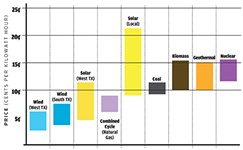Then There's This: Hard, Coal Reality
Breaking up with Fayette Power is hard to do, officials say
By Amy Smith, Fri., Feb. 7, 2014
Baby boomers aren't the only ones postponing retirement.
The long road to moving "Austin Beyond Coal," as the Sierra Club slogan goes, just got longer and more complicated. On Tuesday, utility officials delivered the grim news to the City Council Committee on Austin Energy that severing the city's marriage to the coal-fired Fayette Power Project would carry a cost-prohibitive price tag.
Of course, this message of gloom-and-doom should have been anticipated long before Council won environmental plaudits in 2011 after signing on to a cheery pledge to phase out the plant by 2016, in accordance with an ambitious plan put forth by the Lone Star chapter of the Sierra Club. The promise to eliminate coal from Austin Energy's power generation portfolio also became an environmental centerpiece of Mayor Lee Leffingwell's re-election campaign in 2012, but, like the Council pledge, it lacked specifics on how the city would accomplish such a lofty goal.
Fast forward to 2014 and we hear a different tale of council members expressing remorse and frustration over the grim prospect of utility rates going up 5% to 25%, beginning in 2017, if the city were to unhitch itself from the plant before 2025. A more promising scenario would require a federal carbon tax, which does not appear likely in the near term.
If there's a bright spot to this story, it's that AE has retreated on its recommendation of selling the city's share of the facility it owns with the Lower Colorado River Authority. Environmentalists vehemently oppose the sale because the site east of Austin would still be emitting pollutants even if the city did wash its hands of coal.
At Tuesday's meeting, Khalil Shalabi, AE's vice president for energy market operations and resource planning, laid out a scenario that called for implementing a 2025 shutdown timeline in order to avoid a set of potential legal and financial tangles. By delaying closure, he said, "We would build up a reserve high enough that ... we could [retire the plant] and not affect rates."
Own It, Close It
An earlier breakup would also pose an assortment of other challenges because of the city's ownership arrangement with the LCRA – the two entities share equal ownership of two of the plant's three units (the third is owned solely by LCRA). But the Sierra Club's response is simple: "We want you to go out and gain ownership of one unit of the plant," Dave Cortez, organizing representative for the Austin Beyond Coal campaign, told the council committee. "We know you guys have been surprised by some of the information you've received. We weren't; we knew this would be a very difficult process for you," he said, reminding Council that the sixth largest carbon emitter in the state – Fayette – "is sitting right down the road." He said the 2011 Bastrop wildfires and last Halloween's Onion Creek flood have resulted in an uptick of residents from the affected areas joining the Beyond Coal effort. "They understand climate change," he said. "We implore you to act on their behalf." He also encouraged Austin Energy and City Council to ramp up their outreach by providing more accessible meeting times to allow working families to attend public discussions on Fayette's closure.
Environmentalists have for years claimed that AE's long-term investment in renewable energy sources such as wind and solar should be weighed against not only the cost of purchasing coal, but the costs associated with coal's direct link to health problems and climate change. Even with AE and LCRA dumping some $400 million into the installation of "scrubbers" to capture some pollutants, the scrubbers nonetheless fail to capture carbon.
Dirty Habits
According to data collected from the Sierra Club's Lone Star chapter, Fayette produces 75% of Austin Energy's carbon pollution and sucks an average of 5.75 billion gallons of water from the Colorado River each year. Add to those statistics the notion that Fayette – assuming the city will follow AE's 2025 recommendation – will force the city to continue those dirty, wasteful habits for at least another decade.
Noting that the city is due this year to update its 2020 power generation plan, Council Member Chris Riley asked if AE officials foresee a more optimistic closure timeline if the cost of solar and wind keeps dropping. AE General Manager Larry Weis agreed that the utility needs to be "flexible and nimble" whenever the market shifts up or down, but said he felt more comfortable sticking with a 2025 plan. The utility will, however, stay on course to begin winding down Fayette in 2020, as laid out in the city's existing climate protection goal.
CM Kathie Tovo asked why it would take AE more than a decade to close Fayette when other cities have committed to shuttering their coal plants – as San Antonio aims to do in 2018 – without officials projecting dramatic rate hikes.
AE's Shalabi surmised that those entities probably have the cash balances required and their debt low enough to accomplish such a task. And that's just what the utility is positioning itself to do – build up the utility's reserves and bring down the debt to allow for closure without adverse consequences. It's just going to take longer to get to that point.
Point Austin will return later this month.
Got something to say on the subject? Send a letter to the editor.










